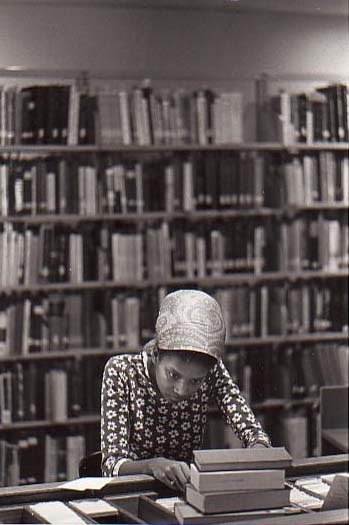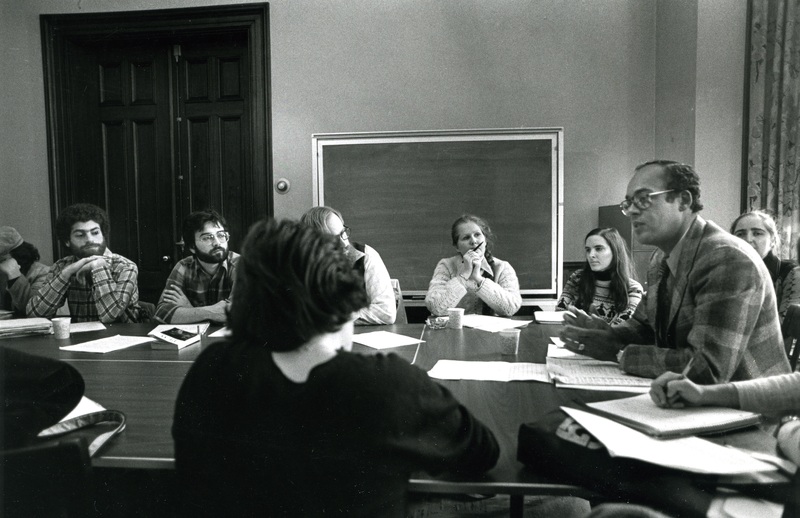The Years of Change, 1960-1999
By the 1960s, major social change was sweeping through the country with the Women’s Liberation Movement and the Civil Rights Movement. Social change shaped this era of Simmons as well. The 1960s and 1970s witnessed an evolution in the original mission outlined by John Simmons almost a century prior with a newly-articulated commitment to diversifying the community. As the College’s fourth president, William Holmes, stated:
“Throughout all of its programs, Simmons is committed to providing students from a diversity of ethnic, racial, and cultural backgrounds with the practical and intellectual means to use their skills and knowledge as scholars and future leaders in their professions and as citizens of an ever-changing world.”
As the College’s mission was reworked, so was the curriculum. In 1963, Simmons offered its first Bachelor of Arts degrees in the School of Education and established a continuing education program for adult students, the Dix Scholars program. An academic department structure also replaced the school structure (e.g., School of Science, School of Home Economics, and School of Education).
Alongside these changes, the College turned its attention to the nation’s growing demand for professionals with graduate degrees. This resulted in the development and implementation of new Simmons graduate programs. These included a Master of Arts in English, a Master of Arts in Teaching, and a Master of Science in Education. In 1974, the College established the Graduate Program in Management, the first and only management program for women. The creation of the Graduate School for Health Studies over a decade later was likewise innovative and brought even more women into the professional healthcare sector.
Just as Simmons tailored its academic offerings to meet the demands of a changing world, the College’s physical landscape was also altered. The five-story Beatley Library/Lefavour Hall complex was completed in 1961, providing space for the College's library, its administrative staff, the School of Library Science, and the Communications Department. This era also brought the Park Science Center in 1972, outfitted with modern laboratories. For the first time, all science programs were centralized in one building.
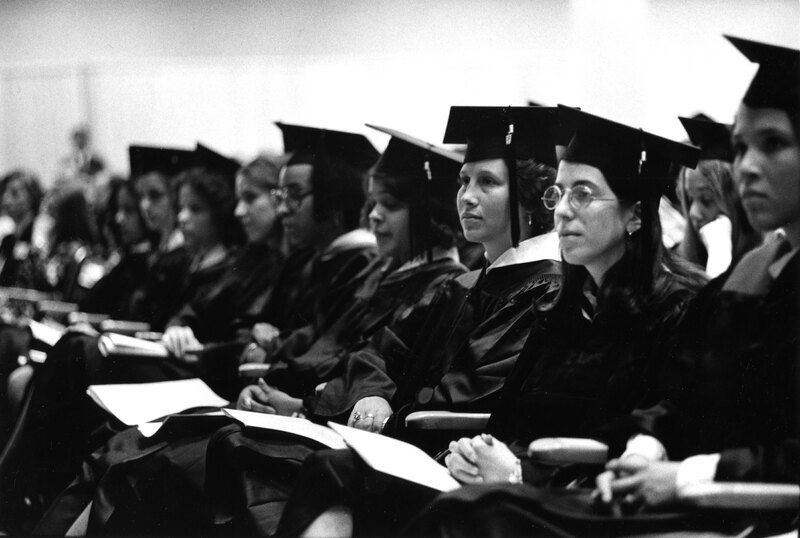
Jocelyn Brady '75 and Elissa Barr '75 posed with unidentified classmates wearing caps and gowns at Commencement, 1975.
In addition, this era witnessed the construction of two new dormitories (Mesick Hall in 1961 and Smith Hall in 1964) along with extensive renovations to the Main College Building, prioritizing the installation of ramps to make the College more accessible for community members with disabilities.
President William J. Holmes oversaw a major two-part fundraising campaign that began in 1975. Part one focused on the College's physical environment, and the second on growing the endowment and increasing the salaries of faculty, staff, and administration.
The Main College Building needed extensive renovation. At a cost of $5 million, this work was completed by 1980 and included new classrooms, restrooms, thermal windows, and heating systems. The Fens dining center was also built on the ground level for cafeteria-style eating.
Earlier generations of students were involved with activism and challenged societal norms, but they also prioritized college traditions. However, by the 1960s, the importance of traditions assumed a secondary position or were largely abandone
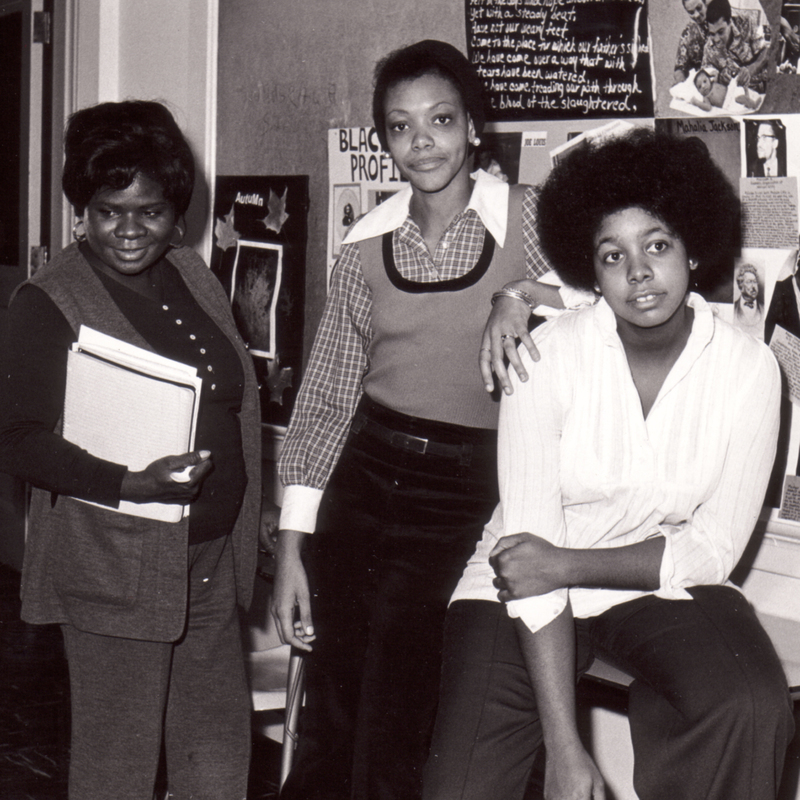
Three unidentified students posed near perhaps the Black Student Organization's bulletin board, 1970s-1980s.
While Simmons reconceptualized the original mission of the College to prioritize diversity in the community during this era, many Black students did not feel their treatment and opportunities were equal to those of their white peers. To both organize a Black activist sphere and create a community of belonging, the Simmons Civil Rights Club was founded in 1965 as the first student organization explicitly dedicated to promoting civil rights. This group became the Black Student Organization (BSO) two years later, and students continued to push the College to live up to its newly-articulated commitment to diversity. Part of this activism included the BSO’s “Ten Demands”, presented to President William E. Park, the College’s third President, in 1969. The demands called for a variety of changes, including curriculum revision that would add a course concentration in African and Afro-American studies, increased recruitment and hiring of Black faculty, students, and staff, and better scholarship support for Black students.
In response, an African American Studies Program began in 1973. The Program’s newsletter, Vantage Point, began that year as well. Our Little Black Book, produced by the BSO, was first released in 1974 and contained photographs of and creative work by Simmons’s Black students. As the number of faculty and staff of color increased, a record 294 black students graduated from Simmons College during the 1970s. The 1980s and 1990s were also marked by the participation of African Americans as Trustees, Corporation members, honorary degree recipients, commencement speakers, staff members, and faculty. Abafazi: A Simmons College Review of Women of African Descent was founded in 1991, publishing scholarly essays, interviews, and studies of the literature and art of Black women. For more information on this and Black history at Simmons, visit the BlackHistory@Simmons exhibit.
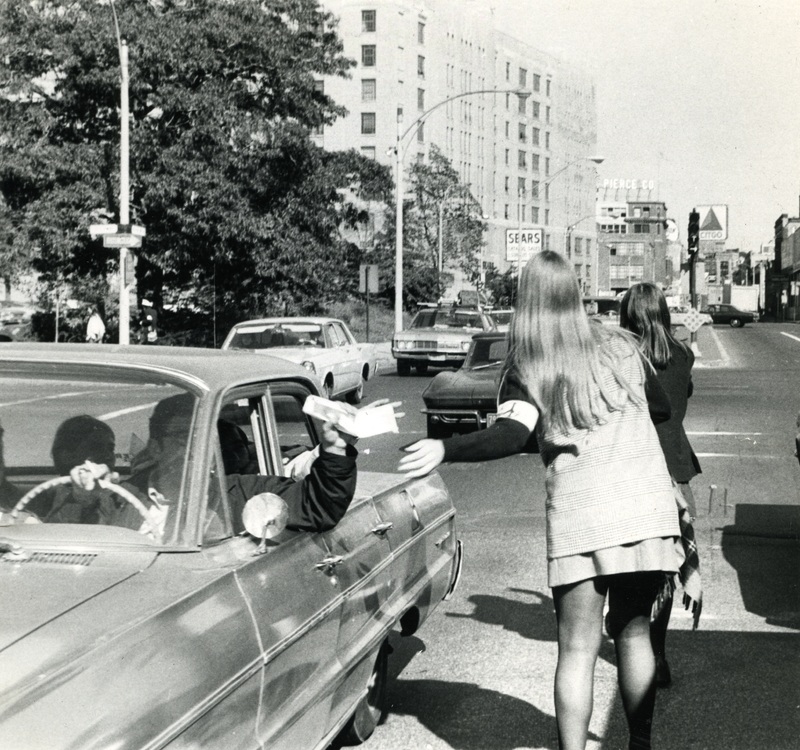
Two unidentified students, wearing "peace symbol" armbands, giving out flyers on Brookline Avenue, 1970.
The activist ethos fostered at Simmons led to other examples of social justice advocacy in the community. Many students protested the Vietnam War. In addition, over 800 students participated in the May Day Protest of 1967, challenging the administration to make faculty salaries more competitive after 10% of faculty left the College earlier that year. The creation of the Lesbian Support Group in 1977 also created space for members of the LGBTQ+ community to express their identity at Simmons and engage in mutual support as well as community-centered education.
From the 1970s through the 1990s, numerous student organizations including the Asian Students Association, the Black-Hispanic Organization, the Latin-American Speaking Organization, the Korean Student Organization, the International Student Organization, and the Caribbean Cultural Association were established. These groups not only formed community in a largely white institution, but created a platform for students to advocate for themselves and to assert a space at Simmons.
As members of the LGBTQ+ community became more active in the public arena during this time, the Gay and Lesbian Awareness Organization was founded in 1986 to create an activist community grounded in mutual support and peer education. The opening of the Women’s Center in 1990 further expanded opportunities to learn about women’s health, promote awareness of gender-based violence, and connect all community members with resources to live fuller lives.
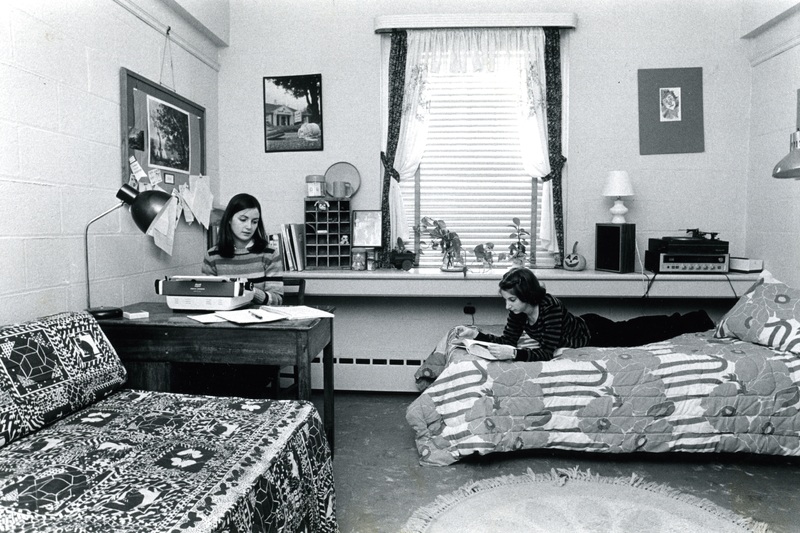
Two unidentified students posed studying at desk and on bed in an unidentified dormitory room, 1979.
The 1970s also saw the emergence of computer technology on campus. Simmons entered the computer age in 1970 when Professor Teresa Carterette brought the first computer to campus for psychology research. Shortly afterward, the Chemistry Department introduced remote-access computing and created the Computer Appreciation Workshop which, for many, was their first contact with computers. Administrative computing arrived on campus in 1977, when Simmons installed its own multi-user computer system. At the same time, Beatley Library served as a test site for an experimental student computer laboratory. Computing at the College also leapt forward in 1984, when the Alumnae Sky Club funded the first full-fledged Microcomputer Lab and Classroom in the Beatley Library building. First steps toward a campus computer network were taken by Physics Professor Edward Prenowitz. The experiments grew into a high-speed network that connected the Main College Building, Science Center, and Beatley Library in 1988.
Title IX of the Educational Amendments of 1972 banned sex discrimination in schools, a catalyst for female participation in sports at Simmons and other colleges across the nation. The gymnasium paved the way for intercollegiate sports when it moved from a small west wing room to the renovated east wing third floor assembly hall in 1979.
Between 1981 and 1985, varsity teams for crew, sailing, tennis, basketball, volleyball, cross-country, and field hockey were formed. Plans were also made for a stand-alone sports center and ground was broken in 1987 behind South and North Halls on the Residence Campus for the Holmes Sports Center, completed in 1989.
The School of Library and Information Science changed its name to the Graduate School of Library and Information Science in 1980, reflecting the growth of one of the College's first course offerings. The Graduate School for Health Studies became the fourth graduate school in 1989 and included Physical Therapy, Health Care Administration, and Primary Health Care Nursing programs. A dual-degree program, Maternal Child Health Nursing, was also established with the Harvard School of Public Health and commenced with the 1988-1989 academic year.
Other programs and cultural opportunities form the legacy of the "modern years." The James P. and Joan M. Warburg Chair in International Relations was endowed in 1983, with former U.S. Ambassador Robert E. White named as first holder. In 1984, the Benjamin and Julia Trustman Art Gallery opened on the fourth floor of the Main College Building where the Library was once located.
As the century came to an end and Simmons celebrated its centennial, administrators began to plan for the institution’s future. The first female Simmons president, Jean Dowdall, led Simmons from 1993-1995. By the later 1990s, President Daniel Cheever, the College’s sixth president, sought to strengthen Simmons’s financial status and bring John Simmons’s vision into the 21st century. Strategic Plan 1999, also called the Campaign for Simmons, brought a $51 million investment in facilities and technology, by far the largest commitment to rebuilding facilities and implementing technology the College had ever made. Two major construction projects were funded as a result: the glass-walled College Center on the rear terrace of the Main College Building in 2000 and the four-story Palace Road academic building in 2002. The School of Management Building began construction in 2005 and opened in 2009. Strategic Plan 1999 also led to the creation of several new academic programs, the renovation of four dormitories, and the consolidation of the School for Health Studies in the Science Center.
Two major events, the Centennial Celebration and the Campaign for Simmons, provided a catalyst for President Cheever, the Board of Trustees, and the entire Simmons community to re-assess and re-establish the College's purpose. As a result, the Simmons College Strategic Plan 2002 was launched to establish a uniform vision across the undergraduate and graduate departments. The strategy of this 2002 Plan was, "to position Simmons as an authority on women, education for the professions, leadership, and diversity.” President Susan C. Scrimshaw would continue to implement this new vision during her brief tenure from 2006-2008.
